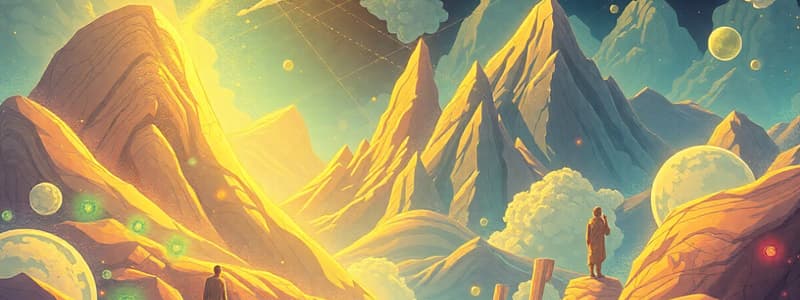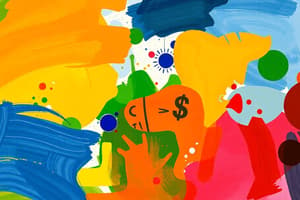Podcast
Questions and Answers
What is the primary focus of economics?
What is the primary focus of economics?
- Investigating historical economic trends
- Exclusively the analysis of government policies
- The study of social behaviors
- Understanding the production, distribution, and consumption of resources (correct)
Which branch of economics examines national economic systems like GDP and unemployment?
Which branch of economics examines national economic systems like GDP and unemployment?
- Macroeconomics (correct)
- Microeconomics
- Market Economics
- Normative Economics
What does opportunity cost refer to in economic decision-making?
What does opportunity cost refer to in economic decision-making?
- The benefits gained from a decision
- The cost of the next best alternative foregone (correct)
- The total expenses incurred by a business
- The financial cost associated with producing a good
Which economic model depicts how households and businesses interact in an economy?
Which economic model depicts how households and businesses interact in an economy?
What is a characteristic of a market economy?
What is a characteristic of a market economy?
What does the unemployment rate measure?
What does the unemployment rate measure?
What does inflation rate indicate?
What does inflation rate indicate?
Which of the following best describes a mixed economy?
Which of the following best describes a mixed economy?
Flashcards are hidden until you start studying
Study Notes
Definition of Economics
- Economics: The study of the production, distribution, and consumption of goods and services.
- Focuses on how individuals, businesses, and governments make choices about scarce resources.
Branches of Economics
-
Microeconomics:
- Examines individual and business decision-making.
- Studies supply and demand, pricing, and market structures.
-
Macroeconomics:
- Looks at national and global economy as a whole.
- Topics include inflation, unemployment, GDP, and fiscal/monetary policies.
Key Concepts
- Scarcity: Limited resources compared to unlimited wants, necessitating choices.
- Opportunity Cost: The cost of the next best alternative foregone when making a decision.
- Supply and Demand:
- Supply: Quantity of a good or service that producers are willing to sell at various prices.
- Demand: Quantity that consumers are willing to buy at various prices.
- Market Equilibrium: Point where supply equals demand, determining the market price.
Economic Models
- Circular Flow Model: Illustrates how money and goods flow between households and businesses through the economy.
- Production Possibility Frontier (PPF): Demonstrates trade-offs between two goods, showing maximum production efficiency.
Economic Indicators
- Gross Domestic Product (GDP): Total value of all goods and services produced in a country over a specific period.
- Inflation Rate: Measures how much prices for goods and services rise over time.
- Unemployment Rate: Percentage of the labor force that is jobless and actively seeking employment.
Types of Economies
- Market Economy: Decisions are driven by supply and demand with minimal government intervention.
- Command Economy: Government makes all decisions regarding production and distribution of goods.
- Mixed Economy: Combines elements of market and command economies, with both private and public sectors involved.
Role of Government in Economics
- Regulates markets to prevent monopolies and protect consumers.
- Uses fiscal policy (government spending and tax) and monetary policy (controlling money supply) to influence the economy.
International Economics
- Trade: Exchange of goods and services between countries. Can be influenced by tariffs, quotas, and trade agreements.
- Foreign Exchange Market: Where currencies are traded, affecting international business and investment.
Current Issues
- Economic inequality: Discrepancies in wealth distribution.
- Globalization: Increasing interconnectedness of economies, impacting jobs and industries.
- Environmental economics: Examines how economic activities affect the environment and how policies can mitigate this.
These notes encapsulate the fundamental aspects of economics, providing a structured overview of key concepts and themes.
Definition of Economics
- Economics is the study of how people make choices in the face of scarcity
- Economics considers the production, distribution, and consumption of goods and services
- It analyzes how individuals, businesses, and governments make decisions regarding scarce resources.
Branches of Economics
- Microeconomics: Focuses on individual economic agents, such as households and firms, and their interactions in specific markets.
- Examines topics like supply and demand, pricing, and market structures.
- Macroeconomics: Analyzes the economy as a whole, encompassing national and global economic trends.
- Studies issues like inflation, unemployment, economic growth, and government policy.
Key Concepts
- Scarcity: The fundamental economic problem, where resources are limited but wants are unlimited.
- Opportunity Cost: The value of the next best alternative forgone when making a choice.
- Supply and Demand: The forces that determine market prices and quantities.
- Supply reflects the quantity of goods or services producers are willing to sell at varying prices.
- Demand reflects the quantity of goods or services consumers are willing to buy at varying prices.
- Market equilibrium occurs when supply and demand are equal, establishing the market price.
Economic Models
- Circular Flow Model: Illustrates the flow of goods, services, and money between households and businesses in an economy.
- Production Possibility Frontier (PPF): A graphical representation of the trade-offs between producing two goods, showing the maximum output achievable with given resources.
Economic Indicators
- Gross Domestic Product (GDP): The total value of all goods and services produced within a country over a specific period.
- Inflation Rate: The rate at which prices for goods and services increase over time.
- Unemployment Rate: The percentage of the labor force that is jobless and actively seeking employment.
Types of Economies
- Market Economy: Economic decisions are primarily driven by supply and demand, with minimal government intervention.
- Command Economy: Economic decisions are centralized, with government controlling production and distribution of goods.
- Mixed Economy: Blends features of market and command economies, allowing for both private and public sectors to play significant roles.
Role of Government in Economics
- Regulation: Government intervenes to prevent monopolies, protect consumers, and ensure fairness in markets.
- Fiscal Policy: Government uses spending and taxation to influence the economy.
- Monetary Policy: Government controls the money supply through actions like setting interest rates.
International Economics
- Trade: Exchange of goods and services between countries.
- Influenced by tariffs, quotas, and trade agreements.
- Foreign Exchange Market: Facilitates the exchange of currencies, impacting international business and investment.
Current Issues
- Economic Inequality: Gaps in wealth distribution within and across countries.
- Globalization: Increasing interconnectedness of economies, affecting jobs, industries, and global trade.
- Environmental Economics: Studies the interaction between economic activity and the environment, seeking solutions to mitigate environmental damage.
Studying That Suits You
Use AI to generate personalized quizzes and flashcards to suit your learning preferences.




